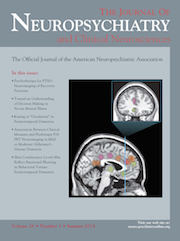Euprolactinemic Galactorrhea With Escitalopram
To the Editor: Escitalopram, a specific serotonin reuptake inhibitor (SSRI), is considered as the first line agent in the treatment of depressive disorders and anxiety disorders because of its efficacy and tolerability profile.1,2 Rarely, SSRIs may lead to increase in prolactin levels with resultant symptoms. We report a young female who developed galactorrhea with normal prolactin levels while on escitalopram for the treatment of anxiety disorder.
Case Report
“Ms. A,” a 24-year-old single woman, presented with recurrent episodes of panic attacks of 6 months duration, which were precipitated when she heard any bad news. There was no anticipatory anxiety between the episodes. Her birth, developmental, and family history was unremarkable. There was no past history of major medical or psychiatric illness. Considering a diagnosis of anxiety disorder not otherwise specified, she was prescribed escitalopram 10 mg per day along with clonazepam 0.5 mg per day, which was tapered off over 2 weeks. After 1 month of therapy, there was significant reduction in panic attacks but she reported having whitish discharge from both breasts suggestive of galactorrhea. Investigations including complete blood counts, and renal and hepatic function tests were normal. Also, thyroid profile and serum prolactin levels were within normal range. Considering a possibility of galactorrhea associated with escitalopram, it was discontinued. There was significant reduction in galactorrhea, which ceased completely after 5 days. She was prescribed a tapering dose of clonazepam as she did not want to take any SSRI including escitalopram and was referred for nonpharmacological management.
Discussion
In this case, there was a clear association of onset of galactorrhea following administration of escitalopram that resolved with discontinuation of the medication. Cases of hyperprolactinemia and galactorrhea induced by SSRIs including sertraline,3–5 fluoxetine,6 escitalopram,7–9 and fluvoxamine10,11 treatment have been reported previously. In most reported cases, drug-induced galactorrhea and gynecomastia have been associated with increased prolactin levels. SSRIs may cause hyperprolactinemia by a serotoninergic-mediated inhibition of dopamine neurons at the hypothalamus, which exert a tonic inhibitory control over prolactin release or direct stimulation of prolactin release through postsynaptic serotonin receptors in the hypothalamus.11,12 Such adverse effects have been categorized as “dopamine-dependent” adverse effects of SSRIs.12 Rarely, galactorrhea is described with normal prolactin levels as seen in our case study, and such euprolactinemic galactorrhea is more frequently reported with escitalopram.13–15 It may be possible that galactorrhea associated with escitalopram occurs through nondopaminergic mechanism. Thyrotropin-releasing hormone (TRH) hyper-responsiveness has been hypothesized to occur with euprolactinemic galactorrhea, though study findings are inconclusive.16 Further studies are required to identify the pathophysiological mechanism of euprolactinemic galactorrhea associated with SSRIs.
1 : The use of escitalopram beyond major depression: pharmacological aspects, efficacy and tolerability in anxiety disorders. Expert Opin Drug Metab Toxicol 2007; 3:741–753Crossref, Medline, Google Scholar
2 : Escitalopram: a review of its use in the management of anxiety disorders. CNS Drugs 2006; 20:763–790Crossref, Medline, Google Scholar
3 : Breast tenderness and enlargement induced by sertraline. Am J Psychiatry 1994; 151:1395–1396Crossref, Medline, Google Scholar
4 : Galactorrhea induced by sertraline. Am J Psychiatry 1993; 150:1269–1270Crossref, Medline, Google Scholar
5 : Sertraline-induced galactorrhea: case report and review of cases reported with other SSRIs. Gen Hosp Psychiatry 2013; 35:e3–e5Crossref, Medline, Google Scholar
6 : Reversible galactorrhea and prolactin elevation related to fluoxetine use. Mayo Clin Proc 2001; 76:215–216Crossref, Medline, Google Scholar
7 : Galactorrhea during escitalopram treatment: a case report. Bull Clin Psychopharmacol 2006; 16:39–41Google Scholar
8 : Escitalopram induced galactorrhoea: a case report. Prog Neuropsychopharmacol Biol Psychiatry 2010; 34:557–558Crossref, Medline, Google Scholar
9 : A case of galactorrhea associated with excitalopram. Psychiatry Investig 2009; 6:230–232Crossref, Medline, Google Scholar
10 : The effect of fluvoxamine on serum prolactin and serum sodium concentrations: relation to platelet 5-HT2A receptor status. J Clin Psychopharmacol 1997; 17:292–297Crossref, Medline, Google Scholar
11 : Euprolactinemic gynecomastia and galactorrhea with risperidone-fluvoxamine combination. Psychopharmacol Bull 2011; 44:70–73Medline, Google Scholar
12 : “Dopamine-dependent” side effects of selective serotonin reuptake inhibitors: a clinical review. J Clin Psychiatry 2004; 65:1064–1068Crossref, Medline, Google Scholar
13 : Citalopram related euprolactinaemic galactorrhoea: a case report. West Indian Med J 2010; 59:100–101Medline, Google Scholar
14 Mahasuar R, Majhi P, Ravan JR: Euprolactinemic galactorrhea associated with use of imipramine and escitalopram in a postmenopausal woman. Gen Hosp Psychiatry 2010; 32: 341.e11–3Google Scholar
15 : A case with euprolactinemic galactorrhea induced by escitalopram. Int J Psychiatry Med 2007; 37:275–278Crossref, Medline, Google Scholar
16 : Euprolactinemic Galactorrhea. Response of bioassayable prolactin to thyrotropin-releasing hormone. J Reprod Med 1996; 41:156–160Medline, Google Scholar



